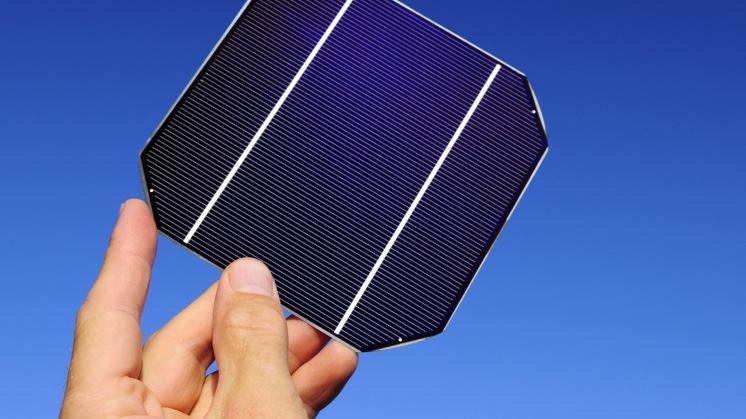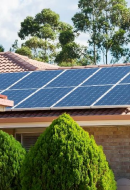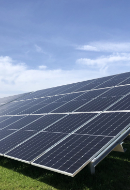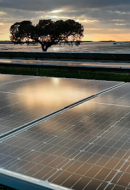Photovoltaic cells
Photovoltaic cells: discover their evolution, their different types and the latest innovations
Solar energy, or photovoltaic energy, is one of the most efficient renewable sources at present and will be key in the process of decarbonising the planet. And all thanks to an essential part: the photovoltaic cell. This electronic device has the capacity to capture and transform light energy into electricity, and in recent years it has continued to evolve in terms of materials and manufacturing techniques.


Photovoltaic cells have become much cheaper in recent years, which has encouraged the use of solar energy.
Photovoltaic energy, which is renewable, clean and inexhaustible, is a key pillar in the process of decarbonising the planet and in the fight against climate change. In fact, in many countries it will be vital for achieving the climate targets set for 2030, more so considering the falling cost of solar panels. Their proliferation is also helping to create green jobs and drive the sustainable development of the economy. And all this is possible thanks to an essential component: the photovoltaic cell.
What is a photovoltaic cell
A photovoltaic cell is an electronic device that converts the energy in the solar radiation that reaches the earth in the form of light (photons) into electrical energy (electrons) thanks to the photoelectric effect.
Major milestones in the history of the development of these cells, include:
- In 1839, French physicist Alexandre-Edmond Becquerel discovered the photoelectric effect.
- In 1883, American inventor Charles Fritts built the first solar cell, which had an efficiency of 1 %.
- In 1905, an article explained the photoelectric effect for the first time. It was written by a 26-year-old German called Albert Einstein.
- In 1954, the Bell laboratory in the United States accidentally discovered that silicon semiconductors doped with certain impurities are hypersensitive to light, and efficiency increased to 6 %.
- In 1957, the Soviet Union launched its first space satellite, which was fitted with solar cells. The United States followed suit in 1958. The space race during the Cold War gave crucial impetus to the development of these cells, increasing their efficiency to more than 15 %.
- Thanks to falling prices, in the mid-90s, solar panels started to proliferate on the rooftops of developed countries, and with the arrival of the 21st-century started to be produced en masse.
How photovoltaic cells work
Photovoltaic cells are composed of two oppositely charged semiconductors separated by a neutral junction: The negative layer (N-semiconductor) is generated by modifying a silicon crystal structure to achieve an excess of electrons and the positive layer (P-semiconductor) lacks an electron to be stable, so it behaves as a positive charge within the crystal lattice. Therefore, a charge neutralisation occurs in the junction area (P/N junction) which, when the N area is exposed to sunlight, releases electrons by increasing the potential difference between the N and P areas. This difference in a closed circuit gives rise to an electric current, part of which is the electricity available to the user.
Inside a photovoltaic cell



Source: US Energy Information Administration (EIA).
 SEE INFOGRAPHIC: Inside a photovoltaic cell [PDF] External link, opens in new window.
SEE INFOGRAPHIC: Inside a photovoltaic cell [PDF] External link, opens in new window.
Types of photovoltaic cells
These days, most photovoltaic cells are made of silicon, because this semiconductor material is plentiful and cheap. It is purified and crystallised before it is cut into thin layers to form the cell. Depending on the silicon manufacturing process, these are classified as:
Monocrystalline silicon cells
They are made up of a single silicon crystal with a uniform structure and guarantee a superior performance to the other silicon cells (18-25 %), because the perfect alignment of their atoms encourages conductivity. Their drawback is that they take longer to manufacture and are more expensive than other types.
Polycrystalline silicon cells
They are made up of numerous silicon crystals and, although the manufacturing process is more economical than that of monocrystalline silicon, their output is inferior (16-20 %).
Amorphous silicon cells
With an irregular atomic structure, this silicon is deposited in thin films on flexible substrates, like glass, metal and plastic, enabling these panels to adapt to any surface for superior architectural integration. Their performance is far lower than that of crystalline silicon (6-8 %), but there are more economical.
As well as these cells, in recent years there have been innovations that are taking this technology to the next level. Multi-junction photovoltaic cells contain multiple P/N junctions made with different semiconductor materials, each of which produces an electric current in response to different wavelengths, in the laboratory setting they are around 45-50 % efficient under concentrated sunlight. Likewise, tandem solar cells can achieve higher yields through monolithic cell stacking with different band intervals, particularly, with a material that promises to be important in the future: perovskite.

Photovoltaic solar panels
What they are, types of panels and how they work.

History of solar energy
Development and progress in photovoltaic solar energy.

Photovoltaic energy terms
Top 10 terms to know about photovoltaic energy.

Photovoltaic self-consumption
Discover this ally in the fight against climate change.
Applications of photovoltaic cells
These days, most photovoltaic cells are used to produce energy for the following purposes:









